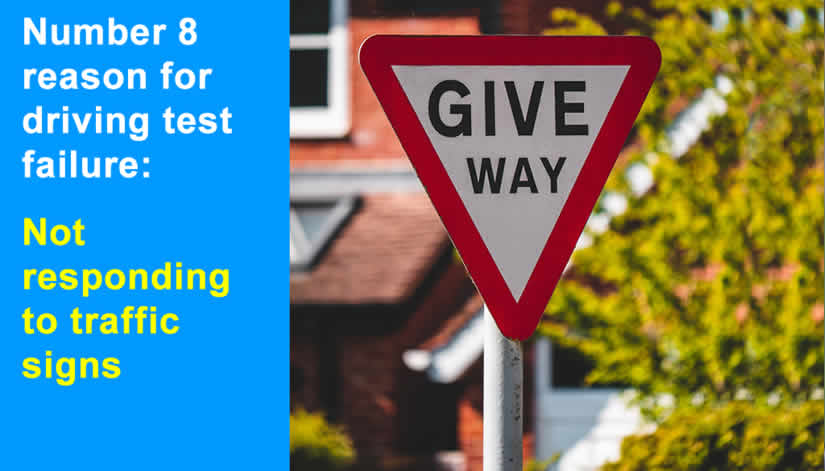Even if you’ve passed the theory test, it’s advisable to keep your knowledge of road rules, road markings and traffic signs refreshed. During your practical test, this will help to ensure that you understand what each road sign means and that you’ll react appropriately to them.
Moving onto number 8 of the top 10 driving test fails, we look at traffic signs, where tests are commonly failed due to test candidates not responding correctly to them. Any faults in this category will be marked under the ‘Response to signals – Traffic signs’ section of the driving test report.
Responding Incorrectly to ‘Keep Left’ Signs
In this instance, the test candidate goes the wrong side of the keep left sign. As the blue circular keep left signs are regulatory, this action will immediately fail a driving test.
Most regulatory road signs inform you of something that you must not do, for example, do not exceed the specified speed limit. Blue road signs are mandatory and generally give positive instruction, for example something that you must do, in this instance, keep left.
Not Acting Appropriately at ‘Stop’ Signs
This fault involves the test candidate failing to stop just before the stop line where a stop sign is located. Where stop signs are located, it’s a legal requirement that a driver must stop their vehicle just prior to crossing a stop line.
Stop signs are usually placed at hazardous ‘closed’ junctions, where visibility is limited and are placed to help reduce accidents. Unlike the broken lines at give way junction signs, junctions with stop signs have a solid white line. Test candidates that fail to stop before crossing the line will fail the test immediately.
Not Acting Appropriately at ‘No Entry’ Signs
This fault involves the test candidate driving through a no entry sign. No entry signs are usually located at the end of a one-way road, where all traffic would be heading towards you.
During the driving test, the examiner may say for example, ‘Take the next available left’. This might mean that the next junction may be an exit only and no entry. This will be marked as a serious or dangerous fault and result in test failure. Always pay attention to all road signs.
Driving in Bus Lanes
Examiners plan driving test routes that have many challenging roads and traffic systems and bus lanes can often be a feature. Driving in a bus lane when it’s not permitted to be used at that time will fail a driving test.
Bus lanes have a sign at the entry point that displays the times that it’s in operation. The times displayed are often during peak times, or ‘rush hour’. For example a bus lane sign may display the time 7.30 am to 9.30 am or 3.30 pm to 6.00 pm on Monday to Friday.
If you’re on a driving test and you’re driving outside of the times displayed, you’ll be expected to use the bus lane if it makes up your driving route, but avoid going into the bus lane if your test is during the hours of restriction. Some busy bus lanes are in operation 24 hours a day, 7 days a week and in this situation, there will be no times or days displayed at all.
Taking the Wrong Lane at a Roundabout
This fault involves the test candidate choosing the incorrect lane at a roundabout, even though there’s clear signage informing drivers of destination routes. The test candidate then proceeds around the roundabout in the wrong lane.
Some roundabouts are complex with many lanes and exit routes and can be confusing. All drivers take the wrong exit or the incorrect lane from time-to-time, but it’s how you deal with the situation that matters.
If you do happen to take the wrong lane at a roundabout during a driving test, continue in that lane and take an alternative route to which the examiner told you. Providing you do so safely and legally, you’ll not fail the test and the examiner will alter the route accordingly.
Not Acting in Time, or Acting too Late for Speed Limit Signs
During a driving test, this involves the candidate failing to adjust their speed for a change of speed limit at all, or adjusting their vehicle’s speed limit too late when a speed limit sign is clearly visible.
It is of course a legal requirement to not exceed speed limits and test candidate that do, will fail the test. When you have observed a speed limit sign ahead, you must slow down in preparation for the new speed and proceed through the speed limit signs at the specified speed.
